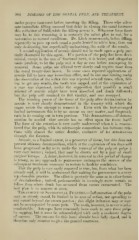Page 894 - My FlipBook
P. 894
904 DISEASES OF THE DENTAL PULP, AND TREATMENT. ;
under proper treatment before inserting the filling. Those Avho advo-
cate inniiediate tilling contend that delay in closing the canal increases
this collection of fluid, ^vhile the filling arrests it. Whatever force there
may be in this reasoning, it is certainly the safest plan to wait for a
restoration to normal conditions. Dr. Litch recommends, before filling,
repeatedly to pass up each canal a probe heated to white heat, thus not
only desiccating, but superficially carbonizing, the walls of the canals.
A second ap};lication of arsenic should not be made upon a pulp par-
tially destroyed by this agent. If a poi'tion of the pulp has been devi-
talized, except in the case of fractured teeth, it is better, and altogether
more prudent, to let the pulp rest a day or two before attempting its
removal. Some pulps are affected very slowly and require more than
the usual twenty-four hours. In some cases repeated applications of
arsenic fail to have any immediate effect, and in one case coming under
the observation of the writer this was repeated several times, when, fail-
ing to get any results, the tooth was capped, and at the expiration of
a year was examined, under the supposition that possibly a small
amount of arsenic might have been absorbed and death followed
but the pulp still retained its full vitality, and was recapped.
The resisting power of the tissue of the pulp after devitalization by
arsenic is very clearly demonstrated in the tenacity with which the
organ resists the attempt to remove it. Even with the best-arranged
barbed instruments this is by no means an easy matter, and frequently
ends in its coming out in torn portions. This demonstrates—if demon-
stration be needed— ^that arsenic has no effect upon the tissue itself.
The force of the retention is very easily understood when it is remem-
bered that the })ulp, M-ith its microscopic connections, has intimate rela-
tions with almost the entire dentine, exclusive of its attachments
through the foramen.
Arsenic, to a limited extent, is a preserver of tissue, but this does not
prevent ultimate decomposition, which at the expiration of ten days will
have progressed so far as to make the removal of the pulp or pulps a
very easy matter ; indeed, they may be drawn out by a pair of small
surgical forceps. A delay, however, in removal to this period of change
is wrong, as any approach to putrescence endangers the success of the
subsequent treatment necessary to restore to healthy conditions.
Tiiat the pulp is very easily removed is true, but, from what has been
already said, it will be understood that waiting for putrescence is a very
reprehensible! practice. The effect is })recisely the same as in other forms
of devitalization ; indeed, pericementitis is seemingly more certain to
follow than where death has occurred from causes enumerated. The
best plan is to remove at once.
Treatment of Superficial Pulpitis.—Inflaramation of the pulp
may, as already stated, be limited in its area of action, not spreading to
any extent Ixyond the crown portion ; this slight irritation may or may
not be accom])anied l)y acute pain. The tooth, however, is never wholly
comfortable. Attempts have constantly been made to save these pulps
by capping, but it must be acknowledged Avith only a moderate degree
of success. Tiie reasons for this have already been fully stated, and it
therefore only remains to give the general treatment.


